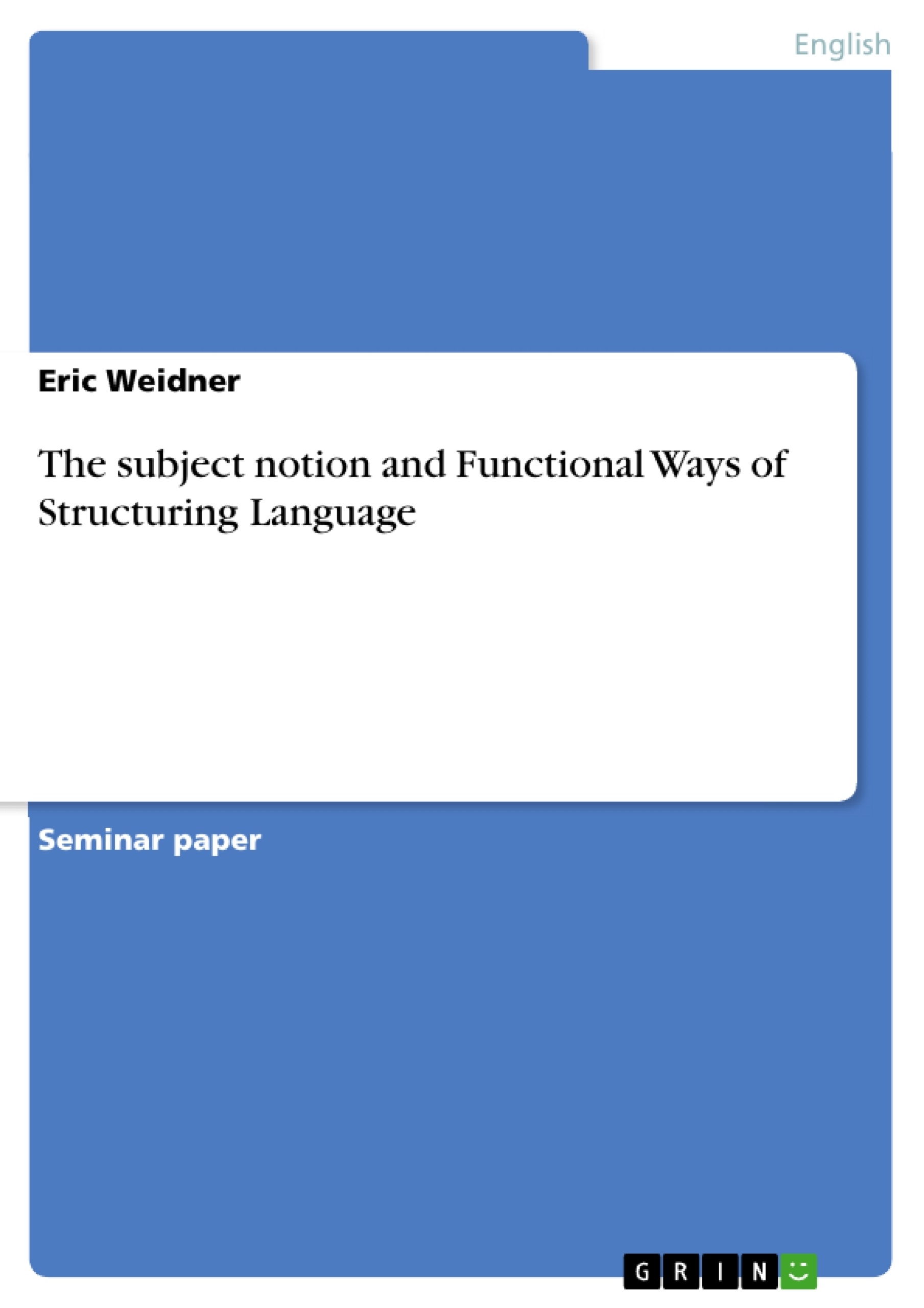In this term paper I will investigate the structure of English sentences with the subject
notion as a starting point. It presents a classical notion to analyse clauses and sentences
but how exactly can a subject be defined? For this purpose, I will show that the notion is
not detailed enough and suggest a distinction into grammatical, logical and psychological
subject. This proves useful to analyse sentences which at first glance do not appear to have
any subject at all. In a next step I will focus on features of the grammatical subject
according to the Cambridge Grammar of the English language (2005). The discussion will
prove that the properties given for grammatical subjects do not constitute a fixed frame
which sharply distinguishes between elements eligible to be subjects and others that are
not. Instead I will argue that the subject category is best analysed as a prototype category
and that its features have prototypical character.
The second section is concerned with different ways of accounting for particular
structures of language. If various syntactic functions can appear at the beginning of
sentences then why does a speaker choose a particular construction instead of another? I
will argue that this question is closely related to analyses of clauses, sentences and
utterances going beyond a mere subject vs. predicate dichotomy. I will start with a
discussion of the thematic structure of sentences and clauses and introduce the distinction
of topic and comment. The second step complements the thematic structure of language
with the information structure, in which constituents can be labelled ‘given’ and ‘new’.
This analysis also considers the intra- and extra-linguistic context of clauses and sentences
and can thereby account for a fair share of speaker-choices between differing
constructions. Since there are still some cases that cannot be explained by looking at the
information structure, I will then present the notion of perspective as very helpful. Taking
together these different levels of analysis one is enabled to account for a large quantity of
possible constructions in the English language.
Table of Contents
- Introduction
- The notion 'subject'
- The category 'grammatical subject'
- Prototypicality of the grammatical subject-category
- Functional approaches and the notion 'subject'
- Topic and comment
- Given and new information
- Figure, ground and perspective
- Conclusion
Objectives and Key Themes
This term paper investigates the structure of English sentences, specifically focusing on the subject notion. The paper argues that the subject notion is not sufficiently detailed and proposes a distinction between grammatical, logical, and psychological subjects. It examines the features of the grammatical subject according to the Cambridge Grammar of the English Language, suggesting that the subject category is better understood as a prototype category with prototypical features. The paper then explores different functional approaches to sentence structure, including topic and comment, given and new information, and figure, ground, and perspective, to account for variations in sentence construction.- The complexities of the subject notion in English syntax
- The distinction between grammatical, logical, and psychological subjects
- The prototypicality of the grammatical subject category
- Functional approaches to sentence structure, including topic and comment, given and new information, and figure, ground, and perspective
- Explaining variations in sentence construction beyond subject-predicate distinctions
Chapter Summaries
Introduction
This chapter introduces the topic of the term paper, which is to investigate the structure of English sentences with the subject notion as a starting point. It argues that the subject notion is not detailed enough and suggests a distinction between grammatical, logical, and psychological subjects. The chapter also discusses the prototypical nature of the grammatical subject category and its features.The notion 'subject'
This chapter defines the term "subject" and distinguishes between semantic/logical subject, psychological subject, and grammatical subject. It uses examples to demonstrate the differences between these concepts and argues that the distinction between grammatical and logical subject is particularly useful in sentences that do not have a clear logical subject, such as sentences with non-referential "it" or imperatives.The category 'grammatical subject'
This chapter discusses the features of the grammatical subject according to the Cambridge Grammar of the English Language. It presents a list of properties that are typically associated with grammatical subjects in canonical constructions, including category, position, case, agreement with the verb, subject-auxiliary inversion, tags, coordination, obligatoriness, and uniqueness. The chapter argues that these properties are best understood as prototypical features, meaning that they may not be consistently present in all cases.Prototypicality of the grammatical subject-category
This chapter further explores the concept of prototypicality in relation to the grammatical subject category. It argues that the properties listed in the previous chapter are not fixed rules but rather prototypical features that may be present to varying degrees in different cases. The chapter uses examples to illustrate how some elements may only partially fulfill the criteria for being a grammatical subject, highlighting the flexible nature of the category.Keywords
This term paper focuses on the subject notion in English syntax, examining its different types (grammatical, logical, psychological), the prototypical nature of the grammatical subject, and various functional approaches to sentence structure, including topic and comment, given and new information, and figure, ground, and perspective. Key concepts include grammatical features of subjects, prototypicality, functional syntax, information structure, and sentence construction.- Citation du texte
- Eric Weidner (Auteur), 2007, The subject notion and Functional Ways of Structuring Language, Munich, GRIN Verlag, https://www.grin.com/document/127136



